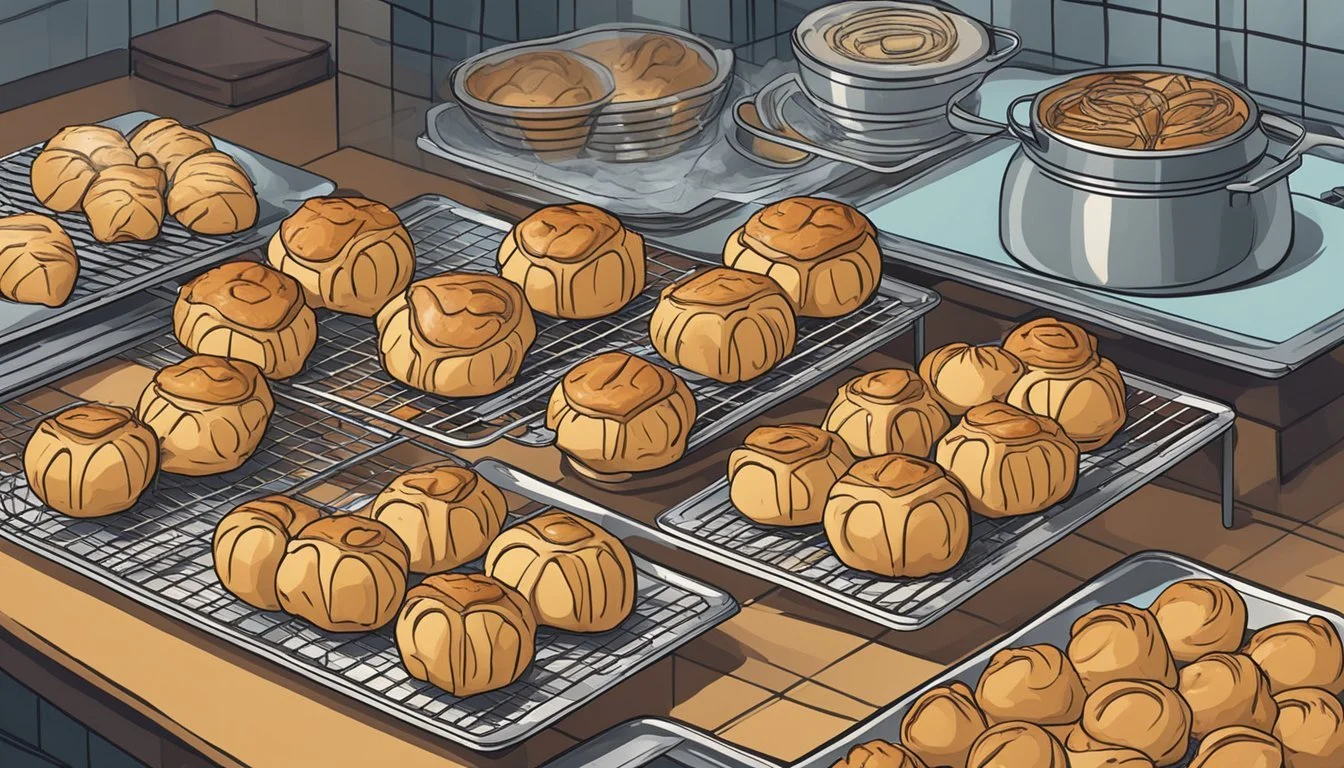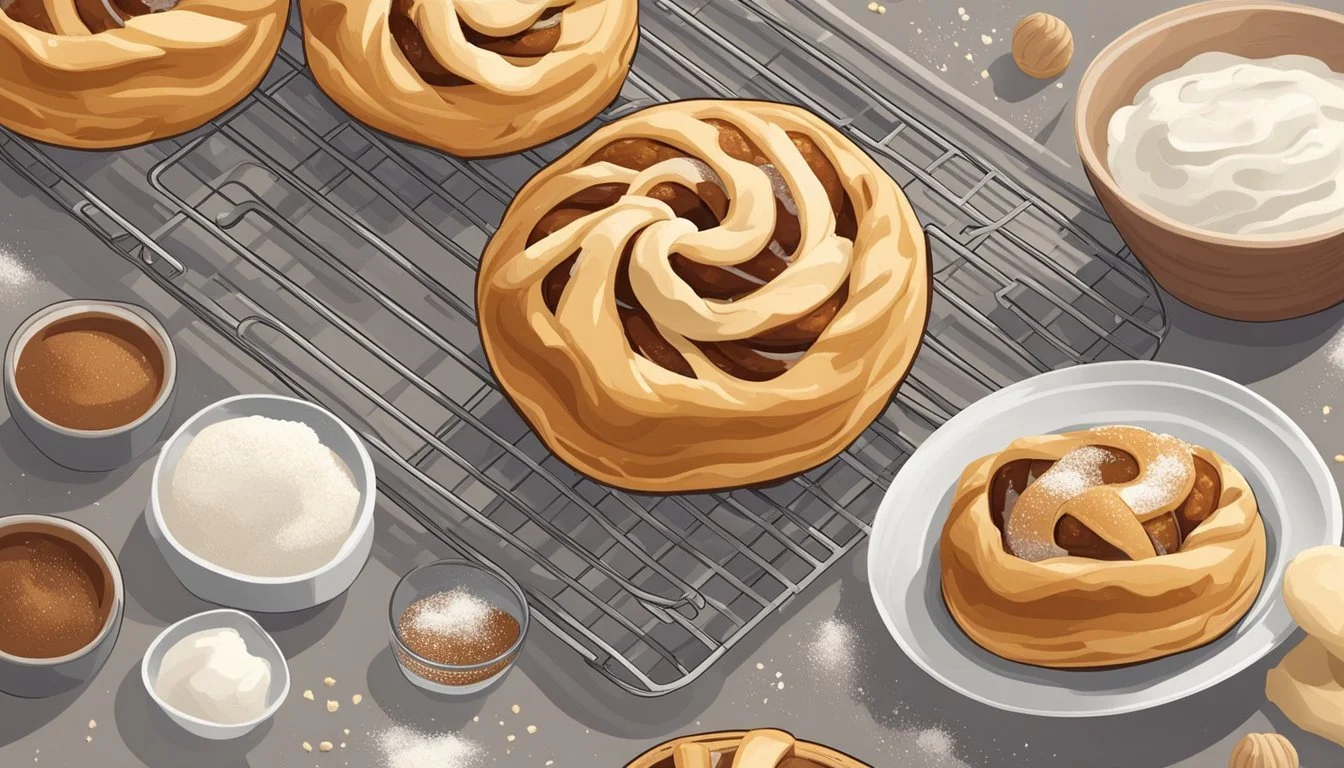How Long Do Freshly Baked Danish Pastries Last?
Shelf Life and Storage Tips
Freshly baked Danish pastries (how long do freshly baked danish pastries last?) are a delightful treat enjoyed by many for their flaky texture and sweet, often fruit-filled, flavors. The shelf life of these pastries is an important factor for both bakers and consumers, determining how long these treats can be savored at their best quality. Generally, if stored properly in an airtight container at room temperature, Danish pastries remain fresh for 1 to 2 days.
If they are to be consumed within a few days, refrigeration can help extend freshness, allowing them to last up to a week. For longer storage, freezing is the most effective method, preserving their quality for up to 2 months. It is important to note that any pastries with cream cheese (how long does cream cheese last?), buttercream, whipped cream, or egg-based frostings should be refrigerated to maintain safety and freshness.
One must take care to wrap the pastries correctly to avoid issues such as soggy textures or flavor spoilage. While wrapping in plastic wrap or placing in sealed containers can maintain the pastries' moisture, it is crucial to avoid using foil wraps that might not provide adequate airflow. Proper storage techniques are key to enjoying Danish pastries at their peak flavor and texture.
Understanding Danish Pastries
Exploring the essence of Danish pastries is crucial to appreciate their freshness and how long they can be savored after baking.
Defining Danish Pastries
A Danish pastry, often simply called a Danish, is a multilayered, laminated sweet pastry in the viennoiserie tradition. The concept was brought to Denmark by Austrian bakers and has since evolved into a myriad of shapes and flavors, typically characterized by its buttery layers and flaky texture.
Common Ingredients in Danish Pastries
Danish pastries are known for their rich texture and flavor which comes from high-quality butter which is integral to the lamination process. Cream, fruit, and cheese are common as fillings, adding moisture and variety to each pastry. Sweet toppings or fillings like chocolate or cream cheese make them indulgent treats. For example, a cheese Danish features cream cheese as its main filling component.
Varieties of Danish Pastries
The versatility of Danish pastries is evident in their varieties:
Filled Danishes: Often stuffed with sweetened cream cheese or fruit preserves.
Fruit Danishes: Topped with fresh or candied fruit, sometimes with a fruit-flavored glaze.
Cheese Danish: Characterized by its creamy and tangy cream cheese filling.
Chocolate Danish: Combines the flaky pastry with the richness of chocolate, either as a filling or a drizzle.
Each type offers a unique combination, but all maintain the classic flaky and buttery texture of the laminated dough.
Freshness and Quality of Danish Pastries
When it comes to Danish pastries, their freshness determines the quality of both texture and taste. These delightful treats are best enjoyed when they exhibit a golden brown exterior and boast a flaky texture.
What Affects Freshness
Factors influencing the freshness of Danish pastries include:
Environmental exposure: Danish pastries are sensitive to air and moisture. Prolonged exposure can lead to staleness or sogginess.
Storage method: Proper storage is crucial. They should be kept in an airtight container to protect from air and in a cool environment to prevent spoilage.
Time: Pastries maintain optimal freshness for 2-3 days at room temperature. Beyond that, this period can extend up to a week when refrigerated and about 2 months when frozen.
Optimal Texture and Taste
The peak texture and taste of Danish pastries are characterized by:
Texture: A perfect Danish pastry should be flaky and light, with a slight crispness to the exterior. This texture is best preserved by ensuring minimal exposure to moisture after baking.
Taste: Freshness ensures the richness of flavor, with the buttery layers and fillings such as custard or fruit retaining their intended taste.
To achieve and maintain the desired golden brown color, texture, and taste, it is essential to consume pastries when they are freshly baked or to apply the proper storage techniques shortly after baking.
Storage Guidelines for Danish Pastries
Storing Danish pastries properly extends their freshness and flavor. It is essential to consider the ingredients and how they affect shelf life.
Room Temperature Storage
Danish pastries can be kept at room temperature for a short period if they do not contain perishable fillings. Pastries should be:
Wrapped individually with parchment paper or plastic wrap to prevent them from drying out.
Placed in an airtight container to maintain quality.
Duration: Typically safe to consume for 1-2 days, depending on the ingredients and ambient conditions.
Refrigeration Tips
Refrigeration is suitable for extending the freshness of Danish pastries, especially those with cream, cheese, or custard. To refrigerate:
Wrap the pastries tightly in plastic wrap or place them in an airtight container.
Keep pastries in the refrigerator to avoid spoilage.
Duration: Refrigerated pastries can remain fresh for approximately 3-4 days.
Freezing for Long-Term Storage
For those who need to keep Danish pastries for an extended period, freezing is an option. Proper freezing entails:
Wrapped pastries in plastic wrap or foil, then placing them inside a freezer-safe airtight container.
Ensuring that the pastries are labelled with the freezing date for future reference.
Duration: Frozen Danish pastries can last for up to 2 months without significant loss of flavor or texture when thawed properly.
Shelf Life and Spoilage Signs
In understanding the conservation and quality of Danish pastries, one must recognize the signs of spoilage, know their expected shelf life, and use prevention methods for mold and bacteria.
Identifying Spoilage
Danish pastries show spoilage through visual signs such as mold growth, which appears as fuzzy or discolored spots. A foul odor or any unexpected change in texture can also indicate that the pastries are no longer safe to consume.
Expected Shelf Life
Danish pastries, when stored properly at room temperature, generally last up to 24 to 48 hours. Refrigeration can extend their freshness to approximately 5 to 7 days. However, this can vary based on the types of fillings and toppings used.
Room Temperature: 24-48 hours
Refrigerated: 5-7 days
Preventing Mold and Bacteria
To prevent mold and bacteria growth, it's crucial to store Danish pastries in a cool, dry place away from direct sunlight. Items should be sealed in an airtight container or wrapped tightly with plastic wrap to keep out moisture and contaminants. If refrigerated, they should be covered to avoid absorbing other flavors and to maintain moisture levels.
Best Practices for Fresh Danish Pastries
To ensure that Danish pastries retain their delicious taste and texture, one must follow certain storage methods. The key to extending the freshness of Danish pastries lies in proper wrapping, labeling, and handling, especially when they have fillings.
Proper Wrapping Techniques
For optimum freshness, pastries should be individually wrapped in plastic wrap or placed in a paper bag, then stored in an airtight container. This method protects the pastries from air exposure and moisture, which can lead to sogginess or staleness. Always ensure the following steps:
Wrap each Danish pastry tightly to create a seal that locks in freshness.
If using a container, remove as much air as possible before sealing.
Labeling and Dating
One should always label and date the pastries when placing them in storage. This practice not only helps in keeping track of their shelf life but also allows for better organization, especially if one is storing different varieties.
To label Danish pastries:
Use a piece of tape or a sticky label on the container or plastic wrap.
Write the date of storage and the type of pastry, if necessary.
Handling Filled Pastries
Filled pastries, particularly those with custard or cheese fillings, require careful attention as they are more prone to spoilage. For pastries like a cheese Danish, the following should be adhered to:
Refrigerating cheese Danish: Store in the fridge if consuming within a week, as the cold temperature hinders bacterial growth.
Freezing cheese Danish: For longer storage, freeze up to two months. Wrap the pastries well to prevent freezer burn and flavor loss.
Storing cheese Danish: Always keep them separated from strong-smelling foods to prevent odor absorption.
By implementing these storage practices, one can enjoy fresh Danish pastries beyond the typical counter-life, whether it’s enjoyed the next day or saved for a later occasion.
Reheating and Serving Suggestions
Proper reheating can restore the fresh taste and texture of Danish pastries, and pairing them with the right accompaniments can turn them into a delightful treat.
Best Methods to Reheat Danish Pastries
To reheat Danish pastries, the oven is often the preferred method to ensure they warm evenly and regain their signature crispiness. The pastries should be placed on a baking sheet, ideally lined with parchment paper, to avoid sticking. An oven preheated to 350°F (175°C) is optimal. Pastries typically require 5-10 minutes to reheat thoroughly. Checking occasionally ensures they do not overcook.
Microwave reheating is quicker but may not yield the same crisp texture. If one must use a microwave, it is recommended to heat the Danish pastries in short intervals of 10-15 seconds to avoid sogginess.
Serving Ideas for Danish Pastries
Once reheated, Danish pastries can be served with various accompaniments to enhance their flavor. Consider the following:
A freshly brewed cup of coffee or tea complements the sweet, buttery flavors.
A light dusting of powdered sugar can add an appealing sweetness and decoration.
To add contrast, pastries can be served with a side of fresh fruit or a fruit compote.
For an extra indulgence, a drizzle of glaze or a dollop of whipped cream can be a splendid addition.
Health and Safety Considerations
When discussing the health and safety of Danish pastries, it's important to consider allergy information pertinent to the key ingredients and adhere to food safety precautions to minimize risks.
Allergy Information
Danish pastries typically contain eggs, milk, and wheat, which are common allergens. Manufacturers and retailers are advised to clearly label these ingredients to inform consumers. Additionally, they often come in varieties that include nuts, posing a risk for those with nut allergies. Establishments should be diligent in preventing cross-contamination for patrons with sensitivities.
Common Allergens in Danish Pastries:
Eggs
Milk
Wheat
Nuts (in certain varieties)
Food Safety Precautions
The freshness of Danish pastries impacts both their flavor and safety. They shouldn't be stored at room temperature for more than two days to prevent bacterial growth. For longer storage, they should be refrigerated in airtight containers and consumed within seven days. Freezing is an option for extending shelf life up to two months, but the quality and texture may be affected upon thawing. Avoiding exposure to strong odors during storage is also important as pastries can absorb them, altering their intended taste.
Storage Tips to Ensure Safety:
Refrigerate if not consumed within two days.
Use airtight containers in the fridge.
Consume within seven days when refrigerated.
Freezing can extend shelf life to two months.
Protect from strong odors.
DIY Baking Tips for Danish Pastries
When embarking on the journey of homemade Danish pastry baking, one should have a clear understanding of the recipe basics and the necessary kitchen equipment. Achieving flaky layers and rich flavors requires precision and the right tools.
Homemade Danish Pastry Recipe Basics
A Danish pastry's success largely hinges on the dough's lamination process. This involves repeatedly folding a butter block into the dough, which is a mixture of flour, sugar, and yeast. Here are some specifics:
Yeast: Use instant yeast for its reliability and ease of use. It doesn't require activation, so one can directly add it to the flour.
Flour: Opt for high-protein flour for better gluten development which helps the pastry hold its structure.
Prep Time: Be prepared to invest time. Creating the butter block and performing the first fold takes approximately 40 minutes, with chilling in between.
Cook Time: Baking is relatively quick, often 15 to 20 minutes in a preheated oven until golden brown.
Total Time: Including all folds and proper chilling, the process can span from 4 hours to 2 days, depending on the recipe's resting requirements.
Kitchen Equipment for Baking Pastries
The right equipment can make a significant difference in the ease and success of baking pastries. Here is a concise list of what one will need:
Stand Mixer: A stand mixer makes quick work of combining ingredients and kneading dough to the perfect consistency.
Rolling Pin: Essential for rolling out the dough evenly, crucial for the lamination process.
Sharp Knives: Clean cuts help preserve the dough's layers, which ensures the pastry rises properly during baking.
Baking Sheets: Heavy-duty baking sheets are preferable for an evenly baked final product.
Parchment Paper: This is key to prevent sticking and for an easy clean-up post baking.
Armed with this information, the process of baking homemade Danish pastries becomes less daunting and more about the delight in creating something delectable from scratch.









